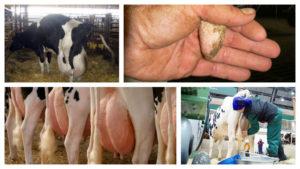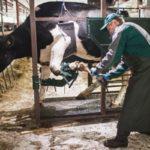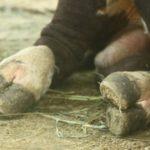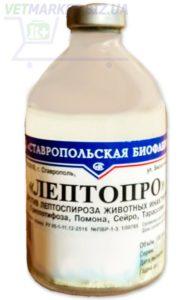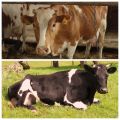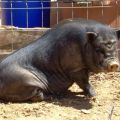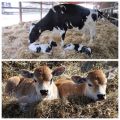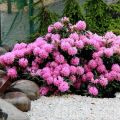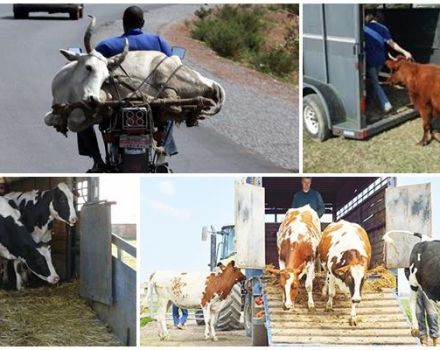Features of the structure of the cow's hooves, what parts they consist of and how many toes
The hoof is a keratinized epithelium formed on the distal portion of the cattle toes. Performs the function of shock absorption: the transfer of impact force during steps, jumps. Different veterinarian authors give different explanations for the structure of the cow's hooves. Some refer to it only the horny shoe, others - all the structures inside it, the rest - skin derivatives. Cattle hooves are often subject to pathologies and deformations and require regular care.
Anatomical structure of the hoof
It is a derivative of the epidermis, keratinized growth or sheath. Consists of several pairs of hooves, with phalanges of 3 and 4 toes. There is a small gap between them. There are additional hooves on the 2nd and 5th fingers: these are rudimentary processes that do not perform a supporting function. The base is a skin case. What other parts does a cow's hoof consist of?
- Coronary strap and pillow.
- Back contour.
- Thin plates.
- Bone elements.
- Outsole and toe pads.
- A layer of particularly sensitive tissue between the hoof and the bone.
The formation of hooves is a slow process: they grow by 4-7 millimeters in a month. These formations perform important functions, including support, protective, depreciation.
Musculoskeletal system of a cow
The limbs of cows are well-muscled. The hind and forelegs regularly support the weight of these massive animals. They also allow individuals to constantly move long distances. The musculoskeletal system of cattle has structural features:
- The forelimbs are attached directly to the skeleton at the sternum. They are called pectorals.
- The hind ones are pelvic.
- The limbs of the cattle include all other parts attached to the frame. These are the pelvic bones and the shoulder blades.

Front leg structure - scapula, forearm, wrist, fingers. The toes is the part of the leg from which the hoof is formed. The hind leg consists of the thigh, pelvic bone, foot and lower leg. The largest part in the structure of the limb is the femoral. Each leg of a cow ends with a hoof.
Using the concept of "legs" for a cow
In veterinary anatomy, it is allowed to use the term "arms / legs" to describe the structure of animals. These are limbs that visually and functionally resemble human ones. The most common definition is used for the order of primates.But is the concept applicable to cows?
The use of the word "legs" to describe the limbs of cattle is permitted. This is due to the fact that the leg of the cow serves as a support, used to move in space.
The use of the word "paws" is incorrect, as they have claws: dense narrow or hook-like points at the ends of the fingers. And cows don't have such formations.

Artiodactyls or not
The main characteristic of the artiodactyl order is the presence of a developed 3 and 4 toes, at the end of which there is a thick horny hoof (shoe or case). In this case, the 2nd and 5th fingers are underdeveloped, and the 1st has a simplified structure. After lengthy disputes, the cows were assigned to the artiodactyl squad. This distinguishes them from horses and other equids, which have only one toe with a hoof covering it.
Cows have 4 toes on each leg. Their arrangement is in pairs: 2 in front, 2 in the back. The hoof in ruminants is bifurcated - this is the main reason for calling individuals artiodactyls. Extremities with a similar structure make the animal capable of locomotion in various terrain: from green meadows to swampy areas.
Possible diseases and prevention
Pathological processes on the hooves develop due to improper maintenance of cows. Provoking factors - uneven floors in the barn, excessively deep litter, lack of manure removal, high humidity. In summer, the risk of disease is exacerbated by prolonged driving on bumpy roads or grazing on swampy ground. The consequences of diseases are deformation of the hooves, violation of gait, falling to the feet.
| Disease | Description |
| Phlegmon | Acute purulent inflammatory process. A frequent complication of puncture injuries, a consequence of prolonged arthritis. Symptoms are acute pain syndrome, fever, detachment of the hoof cover. |
| Coriosis (laminitis) | Inflammation in the parietal layer. The cow feels constant discomfort. It is accompanied by lameness, cracks around the walls, ulceration of the sole of the horn. |
| Hypertrophy | Uneven weight distribution. The threat of deformities to the limb and spine. |
| Interdigital dermatitis | Bacterial infection. It is characterized by lameness, ulceration, and a significant decrease in productivity. |
Prevention of hoof problems involves several measures. Animals are shown only moderate loads. With stall maintenance, a walking area is required. Daily cleaning of manure, slurry, bedding. It is important to monitor the level of humidity: sharp fluctuations, excessive dampness or dryness are unacceptable.
The hoof of a cow is a keratinized solid layer of the epithelium. Consists of hooves, phalanges, fingers. According to the structure of the hooves, cows are classified as artiodactyls. These formations perform the functions of protection and depreciation. Withstand the massive weight of the animal, make walks possible. They need care, pruning, inspection.
